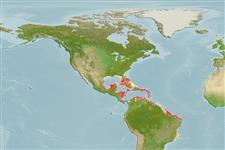Common names from other countries
Classification / Names / Names
ชื่อสามัญ | ชื่อพ้อง | Catalog of Fishes (gen., sp.) | ITIS | CoL | WoRMS
Environment: milieu / climate zone / depth range / distribution range
นิเวศวิทยา
เกี่ยวกับหินโสโครก; กร่อย; ระดับความลึก 5 - 20 m (Ref. 108813). Tropical; 25°C - 33°C (Ref. 86836)
Western Central Atlantic: Caribbean wide.
Length at first maturity / ขนาด / น้ำหนัก / Age
Maturity: Lm ? range ? - ? cm Max length : 10.0 cm BRW เพศผู้/กระเทย; (Ref. 415)
Thin or thick encrustations. Surface is smooth and porous, covered by a transparent membrane. When substrate is overturned, distinct canals converging on oscules are visible. Round oscules, found along the outer edge of the surface; elevated by a tall transparent collar membrane with fine parallel lines. Orange-yellow externally, lighter internally (Ref. 415); specimens may be white in dark habitats. Canals and oscular membrane whitish to transparent. Fragile. Easily torn, spicule tracts may be slightly tough. Exudate absent (Ref. 85482).
It is an epibiotic species found on hard substrates (Ref. 108813). In reefs, encrusting the undersides of corals. Occasionally in mangroves where it can grow to record size (Ref. 415). Lines the edges of plate-like or overhanging stony coral colonies (Ref. 85482).
Life cycle and mating behavior
วัยเจริญพันธุ์ | การสืบพันธุ์ | การวางไข่ | เซลสืบพันธ์ของเพศเมีย(ไข่) | ความดกของไข่ | ตัวอ่อน
Members of the class Demospongiae are hermaphroditic. Life cycle: The zygote develops into parenchymella larva (free-swimming) before settling down on a substrate where it grows into a young sponge.
Collin, R., M.C. Díaz, J. Norenburg, R.M. Rocha, J.A. Sánchez, M. Schulze, A. Schwartz and A. Valdés. 2005. (Ref. 415)
IUCN Red List Status (Ref. 130435)
CITES status (Ref. 108899)
Not Evaluated
Not Evaluated
Threat to humans
Harmless
Human uses
| FishSource |
เครื่องมือ
ข้อมูลเพิ่มเติม
Age/SizeการเจริญเติบโตLength-weightLength-lengthสัณฐานวิทยาตัวอ่อนอุดมสมบรูณ์
แหล่งที่มาจากอินเตอร์เน็ต
Estimates based on models
Preferred temperature
(Ref.
115969): 26.2 - 28.3, mean 27.5 (based on 416 cells).
Vulnerability
Low vulnerability (10 of 100).
Price category
Unknown.
